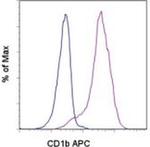Search Thermo Fisher Scientific
Invitrogen
CD1b Monoclonal Antibody (eBioSN13 (SN13 K5-1B8)), APC, eBioscience™
Product Details
17-0018-42
Species Reactivity
Published species
Host/Isotype
Recommended Isotype Control
Class
Type
Clone
Conjugate
Excitation/Emission Max
Form
Concentration
Purification
Storage buffer
Contains
Storage conditions
Shipping conditions
RRID
Product Specific Information
Description: The eBioSN13 monoclonal antibody reacts with human CD1b. The CD1 molecules are similar to MHC class I, but rather than presenting peptide antigens to T-cell receptors (TCR), they present a diversity of lipid and glycolipid antigens which are derived from self as well as from mycobacteria which include sphingolipids, mycolic acid derivatives and phosphatidylinositols such as liparabinomannan (LAM) and glucose monomycolate (GMM). CD1b is 45 kDa, and like the other CD1 antigens, is expressed as a heterodimer composed of the CD1b noncovalently paired with beta2-microglobulin.
Applications Reported: This eBioSN13 (SN13 K5-1B8) antibody has been reported for use in flow cytometric analysis.
Applications Tested: This eBioSN13 (SN13 K5-1B8) antibody has been pre-titrated and tested by flow cytometric analysis of the Molt-4 cell line. This can be used at 5 µL (0.25 µg) per test. A test is defined as the amount (µg) of antibody that will stain a cell sample in a final volume of 100 µL. Cell number should be determined empirically but can range from 10^5 to 10^8 cells/test.
Excitation: 633-647 nm; Emission: 660 nm; Laser: Red Laser.
Filtration: 0.2 µm post-manufacturing filtered.
Target Information
This gene encodes a member of the CD1 family of transmembrane glycoproteins, which are structurally related to the major histocompatibility complex (MHC) proteins and form heterodimers with beta-2-microglobulin. The CD1 proteins mediate the presentation of primarily lipid and glycolipid antigens of self or microbial origin to T cells. The human genome contains five CD1 family genes organized in a cluster on chromosome 1. The CD1 family members are thought to differ in their cellular localization and specificity for particular lipid ligands. The protein encoded by this gene localizes to late endosomes and lysosomes via a tyrosine-based motif in the cytoplasmic tail, and requires vesicular acidification to bind lipid antigens.
For Research Use Only. Not for use in diagnostic procedures. Not for resale without express authorization.
How to use the Panel Builder
Watch the video to learn how to use the Invitrogen Flow Cytometry Panel Builder to build your next flow cytometry panel in 5 easy steps.
Bioinformatics
Protein Aliases: BDCA1; CD1b; CD1B antigen, b polypeptide; CD1C antigen; cortical thymocyte antigen CD1B; differentiation antigen CD1-alpha-3; MGC125990; MGC125991; RP11-101J8.3; RP11-101J8.4; T-cell surface glycoprotein CD1b
Gene Aliases: CD1; CD1A; CD1B; R1
UniProt ID: (Human) P29016
Entrez Gene ID: (Human) 910

Performance Guarantee
If an Invitrogen™ antibody doesn't perform as described on our website or datasheet,we'll replace the product at no cost to you, or provide you with a credit for a future purchase.*
Learn more
We're here to help
Get expert recommendations for common problems or connect directly with an on staff expert for technical assistance related to applications, equipment and general product use.
Contact tech support


